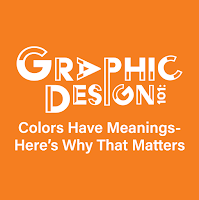This blog post was inspired by Cameron Chapman's post on SmashingMagazine.com at https://www.smashingmagazine.com/2010/01/color-theory-for-designers-part-1-the-meaning-of-color/
Please visit her post for more information, details, and fantastic examples regarding this subject!
Color choice can have a significant impact on the feel that your designs have and it's important to take the meanings of colors into account so that you can ensure that your design carries and portrays the meaning it is intended to through and through with every detail of it. If you use the wrong colors, you can make a design that is intended to feel happy and celebratory feel serious or even somber, and vice versa. It can also make a design that is perhaps aimed at adult audiences make it appear as though it might be aimed more at young children. It is always best to look up the meanings behind colors, especially the ones that you may be intent on using, before you start a project or get too far into working on it - even more so if you are not very familiar with the meanings behind various colors.
Purple
Purple is a color that is often associated with creativity and imagination, but it can also give a design a sense of wealth and luxury, especially if shades like that of the classic "royal purple" are used. It also takes on some attributes of red and blue, such as calmness and responsibility but also passion and love because it is a mix of those two shades.
Blue
Blue is often used as a term to express sadness and depression, however as a color it is often associated with calmness, responsibility, and professionalism, especially those shades of it that are medium to dark in tone. Lighter shades of blue often feel refreshing, hopeful, and calming. It is a color whose impact and overall feel is greatly influenced by how dark or light it is.
Green
Green is an earthly, refreshing, and calming color that can symbolize renewal and abundance. It also has the calming elements of blue and the energizing elements of yellow and consequently can have an interesting harmonizing effect in design. However if used in the right context, it can also symbolize envy and jealousy, hence the phrase "green with envy".
Yellow
Yellow is the brightest and most energizing of all the colors in the rainbow and is often associated with happiness and even sunshine. Using this color can give your designs a sense of happiness and cheerfulness, however it can also give a unique feel of energy and intensity if used sparingly.
Orange
Orange is a often vibrant, energetic color that is strongly associated with creativity. In addition, its strong association with the fruit of the same name, it can be representative of health and vitality as well as refreshment and renewal in some cases, especially if it is particularly bright or even pastel. However it is also associated with the Autumn season when it is muted with undertones of brown and consequently appears more earthy.
Red
Red is a color associated primarily with passion; both anger and love. It can be used to represent both war and violence AND sensuality and sex. It can also be indicative of importance in some cases. With that in mind, it's an extremely powerful color that should be used sparingly as an accent color because otherwise it can be overwhelming. However if it is muted and made to appear lighter and more pastel, it can be less severe and can be used more generously.
Cream/Ivory
Cream and Ivory are shades that feel responsible and professional like blue, black, and white. But especially in comparison to black and white they are shades that are calmer and more relaxing because they are less intense and stark than black and white and instead are very soft. They also carry a sense of warmth with them because of the hints of yellow they often have. This undertone of yellow within them also hints at a feel of aging and time passing, making the colors feel historical in appearance.
Brown
Brown is a warm, natural color that is what most people think of when they think of a "neutral color". It is associated with the earth, wood, and stone and as a result can provide a sense of responsibility and stability. It is often used in the background of designs but is wonderful to use in conjunction with natural-looking textures in design.
White
Because white is the most neutral "color" (if you can even call it that) of them all besides black, it is a shade that is easy to pare with every other color or combination of colors for an additional shade that won't clash with anything around it. It also often symbolizes purity, cleanliness, and sometimes even peace depending on the context in which it's used.
Black
Black is the strongest neutral color and can have a very polarizing effect in art. In some cases it can be positive and represent power, elegance, and formality. However it can be used in negative situations and represent evil, death, mystery, sorrow, mourning, and even rebellion. It is best used in designs that are meant to be particularly elegant or edgy in their expression.
Once again, this post was inspired heavily by Cameron Chapman's post for SmashingMagazine.com at https://www.smashingmagazine.com/2010/01/color-theory-for-designers-part-1-the-meaning-of-color/
I highly encourage you to check it out if you would like to learn more information, explore this topic more in depth, and see some incredible examples of how these colors can be used in art to show everything they represent.













Wow color does play a huge role! I did have a question - do these colors still play a role in brand colors? I see a lot of tech stuff with the color blue which kinda makes sense but was wondering if there are any that don't follow the color meanings.
ReplyDelete- Emma Gamero